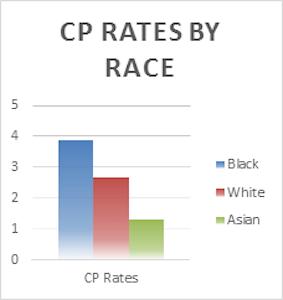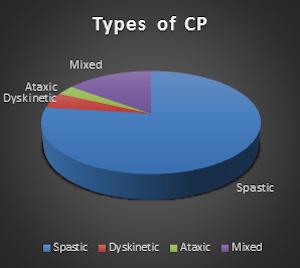Cerebral palsy is one of the most common movement disorders in the world. The highest quality, most reliable statistics on cerebral palsy come from 2 sources:
- ADDM: The primary source for macro-level statistics about cerebral palsy in the U.S. is the Autism and Developmental Disabilities Monitoring (ADDM) network. The ADDM is funded by the federal government and administered by the Centers for Disease Control (CDC). The ADDM has 14 location sites that track the number and characteristics of children developmental disabilities including cerebral palsy.
- SCPE: The European counterpart to ADDM is the Surveillance of Cerebral Palsy in Europe (SCPE) network. The main aim of the SCPE network is to develop a central database of cerebral palsy (CP) cases across Europe. The SCPE data goes back to the 1980s and includes detailed tracking information from over 6,000 children with CP from 13 geographically defined populations in Europe.
Prevalence
- For every 1,000 babies born in the United States, approximately three will be diagnosed with some type of cerebral palsy by the time they are 8 years old. This results in 10,000 babies born with CP every year, making CP the most widespread cause of childhood disability.
- Prevalence rates outside the United States range from as low as 1.5 to as high as 4 per 1,000 live births.
- The rate of CP is believed to be significantly higher in less developed countries with a lower standard of medical care.
- Over 760,000 people in the U.S. are currently living with cerebral palsy. About 65% of these people are under the age of 18.
Demographics
- Cerebral palsy is more common in boys than girls
- Boys = 3.6 per 1,000
- Girls = 2.5 per 1,000
- Cerebral palsy rates are higher in black children than white children with Asians having the lowest rate:
- Black = 3.9 per 1,000
- White = 2.7 per 1,000
- Hispanic = 2.4 per 1,000
- Asian = 1.3 per 1,000
Types of CP
There are 4 different types of cerebral palsy, each with its own unique type of movement disorders: spastic, dyskinetic, ataxic, and mixed. Spastic CP is further broken down into subtypes based on the area of the body affected.
- Spastic CP is by far the most common type of cerebral palsy. Approximately 77% of all CP cases are classified as spastic.
- Dyskinetic CP accounts for about 5% of all CP cases.
- Ataxic CP is the least common at only 3% of all CP cases.
- The remaining cases of CP fall into the mixed category.
Symptoms
Approximately 58% of all children with cerebral palsy are able to walk independently (without the aid of mobility devices).
Around 11% of children with CP can walk independently with the aid of hand-held mobility devices (e.g., walkers, crutches).
The remaining 31% of children with CP are not able to walk independently at all and require the use of wheelchairs.
At 8 years old, about 60% of children with CP will be diagnosed with another, co-occurring developmental disability:
- Intellectual delay is the most common co-occurring disability. Approximately 40% of children with CP also have some form of intellectual disability.
- The second most common co-occurring condition is epilepsy, which occurs in 35% of children with CP.
- Vision impairment is a co-occurring condition in 15% of cases.
- Children with CP are three times more likely to experience pain in activities requiring motor skill performance
Causes & Risk Factors
Cerebral palsy is caused by developmental abnormalities or damage to the developing brain causing impairment of the brain’s ability to control body movement. The brain damage that results in CP typically occurs during pregnancy or childbirth. The CDC estimates that 90% of all cerebral palsy cases are the result of damage to the brain occurring during pregnancy or childbirth. Other statistics demonstrate clear risk factors.
- Low Birth Weight : babies born with a birth weight between 3-5 pounds are twice as likely to be diagnosed with CP with a prevalence rate of 6.2 per 1,000. For babies that are under 3 pounds at birth, the prevalence rate skyrockets to 59.5 per 1,000 live births. By comparison, the rate for children with a normal birthweight (over 5.5 lbs.) is 1.1 per 1,000.
- Prematurity : when babies are born in week 37 or later of pregnancy, the rate of CP is only 1.4 per 1,000. When a baby is born at 32 to 36 weeks gestation, the CP jumps up to 6.1 per 1,000. At 28 to 31 weeks gestation, the rate of CP shoots up to as high as 79.5 per 1,000 births.
- Multiples : babies that are twins, triplets or other multiple birth pregnancies are 5 times more likely to be diagnosed with CP compared to individual babies. This is partly due to the fact that twins and multiples have a much higher rate of prematurity.
- HIE : Hypoxic-ischemic encephalopathy (HIE) is a very serious type of brain injury resulting from blood and oxygen deprivation during childbirth. HIE accounts for approximately 20% of childbirth cerebral palsy cases.
- Maternal Infections : infections in pregnant mothers, have been linked to increased risks of CP. Chorioamnionitis (an infection of the placental membranes or amniotic fluid) has been attributed to 12% of spastic CP cases in full-term babies and 28% in premature babies.

